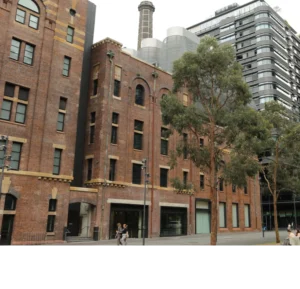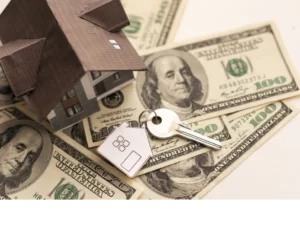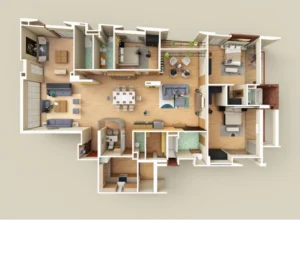How to Calculate Them

Capital Gains on Rental Property
Capital gains on rental property can feel like one of those things no one tells you about—until it’s time to sell. Suddenly, you’re hearing tax terms, numbers, and rules you’ve never thought about before. But don’t worry—we’re breaking it all down for you. In this guide, we’ll walk through how capital gains work, how they’re taxed, and the smart moves you can make to keep more of your profit. Read along to get answers.
Main Takeaways
- Capital gains tax on rental properties depends on how long you’ve owned the property—short-term gains are taxed like regular income, while long-term gains have lower rates (0%, 15%, or 20%).
- The IRS calculates capital gains based on your adjusted basis, factoring in depreciation, improvements, and selling costs. Depreciation recapture is taxed separately at 25%.
- You can minimize capital gains taxes by holding the property for over a year, tracking improvements, offsetting gains with losses, or converting a rental into a primary residence—though rental years affect exclusion eligibility.
What Are Capital Gains on Rental Property?
Let’s say you bought a cozy rental unit a few years ago—nothing fancy, but the location was good, and you saw potential. Maybe you’ve been managing it yourself, fixing a leaky sink here and there. Or maybe you’ve had a team keeping things running smoothly.
Fast forward a few years, and you decide it’s time to sell. The market’s up, and you walk away with a nice profit. That extra money in your pocket? That’s what we call capital gains. Making a profit is great, but it also means paying more in taxes, depending on how much you made and how long you owned the property.
Short-Term vs. Long-Term Capital Gains
There are two types of capital gains: short-term and long-term. The difference comes down to how long you’ve owned the property. Let’s break each one down:
Short Term Gains
If you sell a property you’ve owned for a year or less, the profit is called a short-term capital gain. And here’s the thing, short-term gains are taxed just like your regular income. That means the more you earn in a year, the more tax you might have to pay on that gain. In the U.S. Federal tax, those tax rates can range from 10% all the way up to 37%, depending on your income.
Long-Term Gains
If you sell a property you’ve owned for more than a year, any profit you make is considered a long-term capital gain. This is often the preferred route for many investors, and here’s why: the taxes are usually much lower.
As of 2025, long-term capital gains are taxed at 0%, 15%, or 20%, depending on your total income.
- 0% Rate: Applies to single filers with taxable income up to $48,350 and married couples filing jointly with income up to $96,700.
- 15% Rate: For single filers earning between $48,351 and $533,400, and married couples filing jointly earning between $96,701 and $600,050.
- 20% Rate: Applies to single filers with income exceeding $533,400 and married couples filing jointly with income over $600,050.
For example, if you’ve made a profit and you fall into the 15% bracket, that’s the rate you’ll pay on your gain. As you can see, if you’re not in the highest income bracket, you could end up paying significantly less in taxes compared to selling a property you’ve only owned for a short time.
Holding onto the property longer gives it time to gain value. Plus, since it falls under the long-term category, you’ll likely pay less in taxes when you sell. It’s a simple move that helps you make more and keep more in the end.
Important Note: There are also state capital gain taxes, so you must factor those in, too.
How Capital Gains Are Calculated on Rental Property
When you sell a rental property, the IRS doesn’t just subtract your buying price from your selling price to figure out your profit. Rather, they use something called your “adjusted basis,” which is just a fancy way of saying what the property has cost you over time, not just what you paid for it.
Here’s what goes into the calculation:
-
Start with what you paid for the property
-
Subtract any depreciation (i.e, if you’ve been claiming it on your taxes)
-
Add any big upgrades or improvements (like a new roof or kitchen remodel)
-
Add selling costs (like agent fees, legal fees, or repairs done right before selling)
A Simple Example
Let’s say you bought a rental home for $200,000.
- Over time, you depreciated $20,000 for tax purposes.
- You spent $30,000 on improvements (like a new kitchen and bathroom)
- You paid $10,000 in selling costs (agent fees, repairs, etc.)
Your adjusted basis would be:
$200,000 – $20,000 + $30,000 + $10,000 = $220,000
Now, imagine you sold the house for $300,000.
Your capital gain is:
$300,000 – $220,000 = $80,000 profit
That $80,000 is what the IRS sees as your capital gain—and it’s what they’ll tax depending on whether it’s short-term or long-term.
Strategies to Minimize Capital Gains Tax
Let’s explore some practical strategies to help you minimize capital gains tax when selling your rental property. We will make it simple for you to follow and execute:
1. Hold Onto the Property for Over a Year
From our discussion before, you can tell that long-term gains attract a lower tax. So, if you hold onto your property for more than a year before selling, any profit you make is taxed as a long-term capital gain—and that usually means paying less in taxes.
2. Offset Your Gains with Capital Losses (Tax-Loss Harvesting)
Let’s say you made a profit from selling your rental property—that’s your capital gain. But let’s also say you have another investment (like stocks or another piece of property) that didn’t do well, and you lost money on it. That’s called a capital loss.
Now, here’s the smart move: You can sell that losing investment and use that loss to reduce the amount of profit you’re taxed on.
3. Keep Track of Property Improvements
When you keep all the receipts for improvements you’ve made—like remodeling the kitchen, replacing the roof, and more—those improvements are one thing you can use for tax reduction. Yes, the IRS counts that as part of your cost basis, which means you could end up paying less tax when you sell.
4. Convert the Property to Your Primary Residence
So normally, when you sell a rental property, the IRS taxes your profit as a capital gain, right?
But there’s a special tax break for people who sell their main home (the one they actually live in).
Here’s how it works: If you move into your rental property and live there for at least 2 years out of the last 5 years before selling it, the IRS lets you exclude up to $250,000 of capital gains ($500,000 for married couples filing jointly).
However, if the property was previously a rental, only the portion of the gain related to the years it was your primary home qualifies for exclusion. The IRS prorates the exclusion based on how long the property was rented versus how long it was a primary residence.
Additionally, depreciation recapture still applies, meaning any depreciation claimed while the property was a rental must be taxed separately at 25%, even if the gain qualifies for partial exclusion.
Depreciation Recapture: What You Need to Know
If you’ve owned a rental property, you probably claimed depreciation each year to lower your tax bill. That simply means you told the IRS your property was “wearing out” a little over time. And in return, you got a tax break.
Sounds like a good deal, right? It is… until you sell.
When it’s time to sell the property, the IRS “recaptures” those tax breaks you’ve been enjoying. In simple terms, they’ll tax you on the total amount of depreciation you claimed, even if you didn’t make a big profit. So, let’s say that over the years, you claimed $20,000 in depreciation.
When you sell, you might have to pay tax on that $20,000—usually at a rate of 25%. That’s what they call depreciation recapture. Knowing this ahead of time can help you plan better, avoid surprises, and decide the best time to sell.
How to Handle Capital Gains Tax When Selling a Rental Property
Capital gains on rental property are taxed based on how long you’ve owned the property. Short-term gains are taxed like regular income, while long-term gains have lower rates. To calculate capital gains, the IRS considers your adjusted basis.
Essentially, this includes depreciation, improvements, and selling costs. Investors can minimize taxes by holding the property longer, tracking improvements, offsetting gains with losses, and converting rentals into primary residences. Still, though, you must account for depreciation recapture.
Capital gains tax can sound overwhelming at first. But once you break it down, it’s actually pretty manageable. A few smart decisions, a bit of planning, and you could end up saving more than you expected when it’s time to sell. The best part? You don’t have to wait until you’re listing your property to start thinking about it. The sooner you understand how it all works, the better positioned you’ll be when that day comes.
Source: Bay Property Management Group













 Accessibility
Accessibility